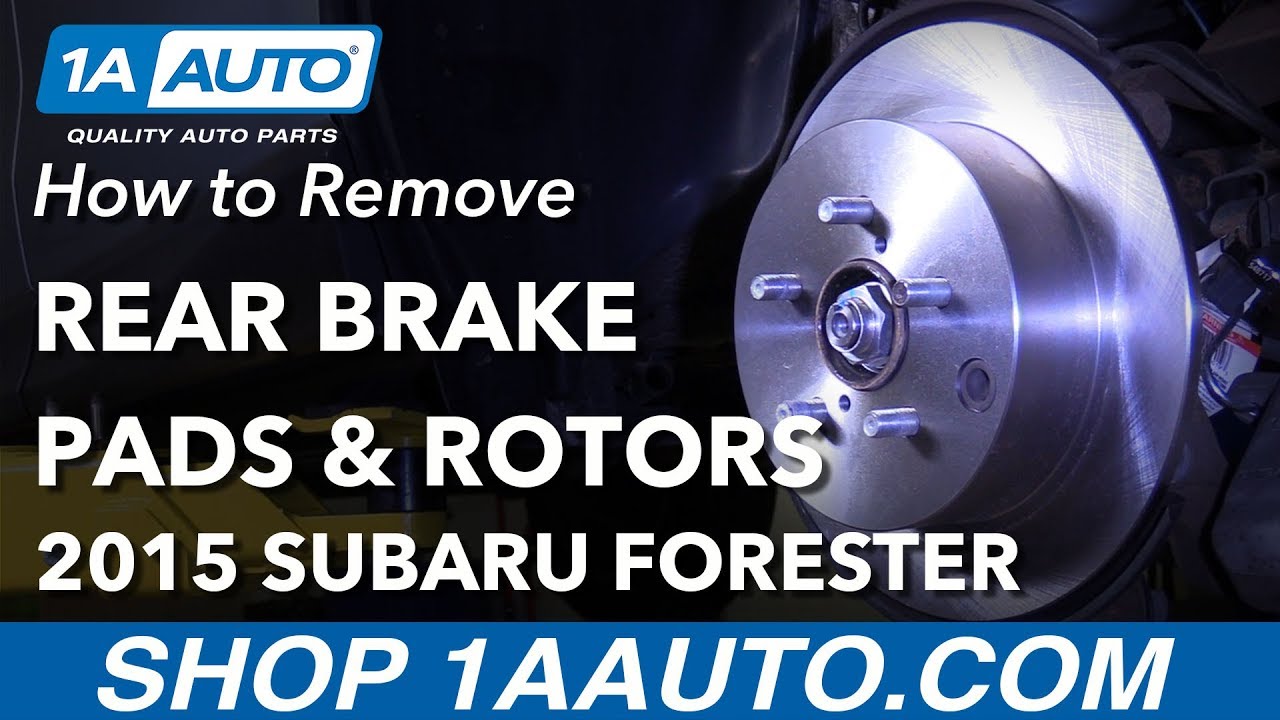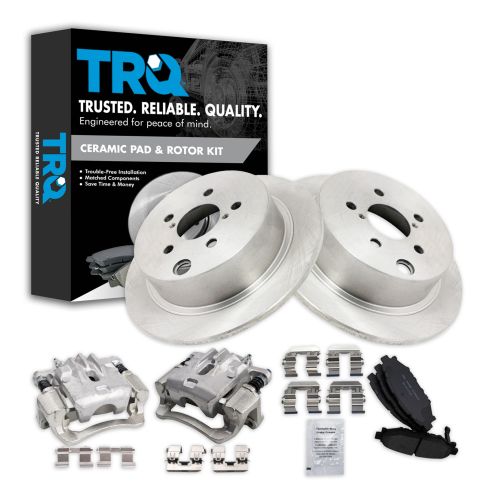
How to Replace Rear Brakes 2013-18 Subaru Forester
Created on: 2018-06-29
How to repair, install, fix, change or replace your own worn, squeaky, fading old brakes on 13, 14, 15, 16, 17, 18 Subaru Forester
-
step 1 :Removing the Wheel
- Loosen the 19mm lug nuts with the vehicle on the ground
- Raise the vehicle with a floor jack
- Secure the vehicle on jack stands
- Remove the lug nuts
- Pull off the wheel
-
step 2 :Removing the Brake Pads and Rotors
- Remove 14mm bolts from the brake caliper
- Pull the caliper aside and secure it with a bungee cord
- Pry the brake pads off with a flat blade screwdriver
- Remove 14mm bolts from the brake caliper bracket
- Pull off the brake caliper bracket
- Pull the rotor off
-
step 3 :Preparing the New Brake Pads and Rotors
- Clean the brake pad slides with a wire brush
- Clean the caliper with a wire brush
- Apply grease to the caliper slides
- Clean both sides of the rotor with brake parts cleaner
-
step 4 :Installing the New Brake Pads and Rotors
- Transfer the grommet from the old rotor to the new one
- Slide the rotor on
- Put the caliper bracket back into place
- Start the bolts by hand
- Tighten the bolts to 48 foot-pounds of torque
- Add grease to the brake pad tabs
- Install the new brake pads into the bracket
- Put an old pad in the caliper
- Use a large C-clamp or compressor tool to the old pad to push the pistons back
- Put the caliper on
- Thread bolts by hand
- Torque bolts to 19 foot-pounds
-
step 5 :Reattaching the Wheel
- Slide the wheel into place
- Start the lug nuts by hand
- Tighten the lug nuts preliminarily
- Lower the vehicle to the ground
- Tighten the lug nuts to 89 foot-pounds in a crossing or star pattern
-
step 6 :Testing the Brakes
- Pump your brakes repeatedly until they feel firm
- Test your brakes at 5 miles per hour and then 10 miles per hour
- Road test the vehicle
Tools needed
-
14mm Wrench
Socket Extensions
Flat Blade Screwdriver
17mm Wrench
17mm Socket
19mm Socket
Bungee Cord
Anti-Seize Grease
Ratchet
Wire Brush
Brake Parts Cleaner
Hi, I’m Mike from 1A Auto. We’ve been selling auto parts for over 30 years!
In this video, we will be replacing the rear brakes on a 2015 Subaru Forester. If you need these parts or other parts for your vehicle, click the link in the description and head over to 1AAuto.com.
We'll take this wheel off. We're going to put a 19 millimeter socket on our breaker bar. We're going to loosen these lug nuts before we take the vehicle and put it up in the air. So we'll take these lug nuts off. Now, pull the tire off.
Now we'll take these two caliper bolts off. I'm going to use a 14 millimeter wrench. Take these bolts off. Now I'm going to grasp the caliper, twist it back and forth, and I should be able to pull it out, just like that. Then I'm going to take a bungee cord. Install one through one hole. Go around here on the backside above the upper control arm. Then come around the back, and just have that sitting out of the way.
Next I'm going to take these pads out. Use a screwdriver to get underneath here. These ones are kind of stuck in there a little bit. Pry them out. Do a little tap, and then pry out the inboard ones, just like that. All right, now we're going to take this caliper bracket off. We're going to take these two 14 millimeter bolts out. I'm going to use a 14 millimeter socket and a ratchet. Pull that bolt out. I'll take the top bolt out, and slide the bracket off towards the back of the vehicle.
All right, to get the rotor off, I can take a hammer and hit all around here. We actually sell these hammers at 1AAuto.com. But in addition to that, there's these two little holes that are threaded. You can find some bolts that thread into them. This'll help you get it off a little bit. So we'll thread these on, and you can take a ratchet, and just snug these up a little bit. Just a little bit. You don't want to tighten it too much, because it's just going to strip it. So if you do that, that just puts a little pressure on the rotor, to make it come out a little bit.
Then we'll take our hammer, we're going to hit all around here. Tighten these bolts up a little bit more. And the rotor is loose enough to pull it off. All right, so we're going to clean up this caliper bracket. We use a little wire brush. Get in here and get all this corrosion and rust out. A lot of brake dust in here. I'll take a flat blade screwdriver, and we'll pull this pad guide out under here. Pull that off and set that aside.
We'll take our wire brush again, and just get in here. Clean that out, and clean out some of the off the back, but it's generally not too bad. All right, so now we'll put this pad guide back in. Push that down. And we'll do the same for the other side.
Next, we're going to pull out these caliper guide pins. We're going to spray these down with some brake parts cleaner, and wipe them down with a rag. Those are nice and clean. Now we can spray some brake parts cleaner down here. And then we'll take our rag and wipe it down.
Pull that out and drain it out. And then we'll take some caliper grease, and coat the guide pin, and then we'll reinstall the guide pin. And make sure that boot goes all the way around. And do the same for the other side.
All right, so now I'm going to take a wire brush, and we'll clean up the hub area. Get all in here. Just clean up some of the rust. We'll put the rotor on backwards for a second. We're going to take some brake parts cleaner. Clean the backside of the rotor, and we'll wipe it down as a protective coating on the rotors. We want to get that protective coating off. That prevents them from rusting. And we'll flip it over, and do the same to this side. And wipe it off with a rag.
We're going to take this old grommet out of the old rotor, and we're going to transfer it to the new rotor. Stick that in. We'll take our caliper bracket. Line that up on the rotor. It has two bolts. Get those both started. Now we're going to torque these caliper bolts to 48 foot-pounds. We're using a 14 millimeter socket and a torque wrench. You can get this torque wrench at 1AAuto.com.
Now we're going to install the brake pads. We're going to just use a little bit of brake grease on the ends of the brake pads, and a little bit in the middle here. Don't get any on the friction material. Now I'll install that onto the caliper bracket, like that. And do the same for this one as well. That one on the inside. That's good. Now I'll take the bungee cord off the caliper. Flip it over. I'm going to take one of the old brake pads, slide it right there, and I'll take this brake caliper compressor tool, and we'll compress the caliper.
We sell these tools at 1AAuto.com. And we'll compress the caliper, so the piston is going back into the caliper. When the piston is doing this, this is sending brake fluid through the hoses, through the lines, back up to the master cylinder, and into the brake reservoir. And because we did not take off the hose on the caliper, we do not have to bleed the system after we're done.
So now we'll slide our piston over the brake pads. Line that up. Take our caliper bolts. Slide these in here. I'm going to use a small extension for the top one, because the brake hose gets in my way.
Now, throw up the tire. I'll stick the lug nuts on. Now we're going to torque these with a torque wrench in a star pattern, with a 19 millimeter socket and a torque wrench to 89 foot pounds. The reason you want to do it in a star pattern is to get the wheel tightened evenly. Before we take the vehicle and take it for a ride, we're going to want to pump the brake pedal, because what's happening is, there's an air gap between the brake caliper piston and the brake pad. So when we pump the pedal, that's pushing fluid back down to the calipers, and getting rid of that air gap. And once the brake pedal feels good, then you're good to go.
Thanks for watching. Visit us at 1AAuto.com for quality auto parts, fast and free shipping, and the best customer service in the industry.
Shop Products
 Subaru Rear Driver & Passenger Side 2 Piece Premium G-Coated Performance Brake Rotor Set TRQ Performance BRA74788
Subaru Rear Driver & Passenger Side 2 Piece Premium G-Coated Performance Brake Rotor Set TRQ Performance BRA74788

Subaru Rear Ceramic Brake Pad & Rotor Kit with Calipers TRQ BKA26408
Part Details:
- Solid
- 10.79 in. (274mm)
- Premium Posi
- 5 Lug
- Ceramic
- (2) Rear Brake Rotors
- (1) Rear Ceramic Brake Pad Set
- (2) Rear Brake Calipers

How To Replace Rear Disc Brake Pads and Rotors 2004-10 Ford F150
Check out this video to learn how to replace the rear brake pads and rotors on your 04-10 Ford F150. 1A Auto will show you the steps.





